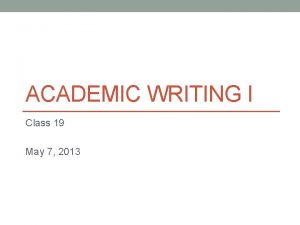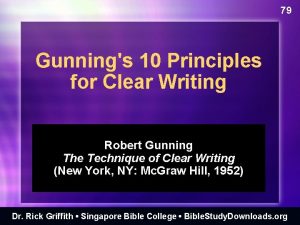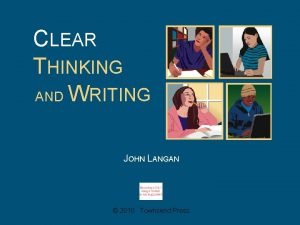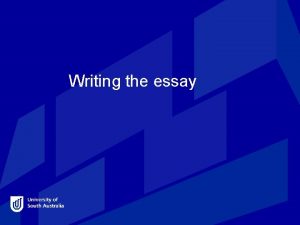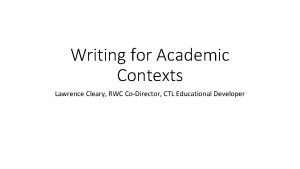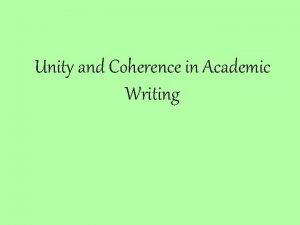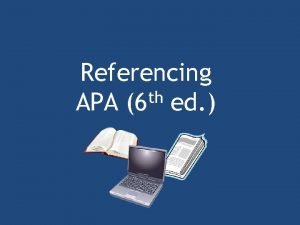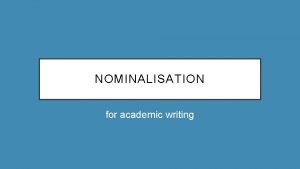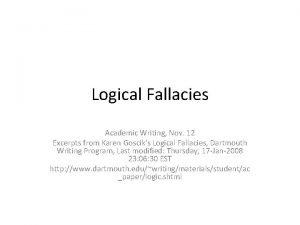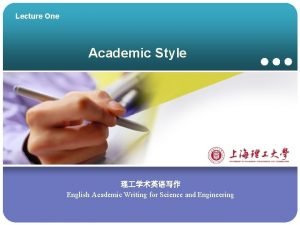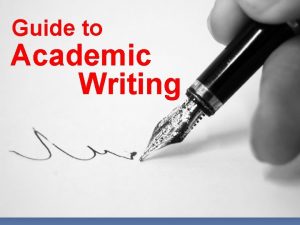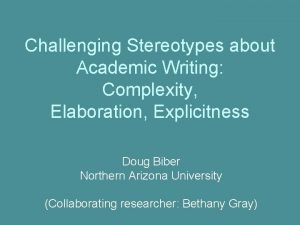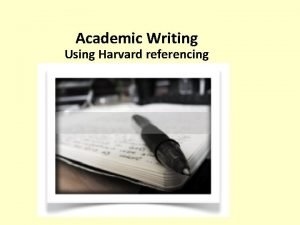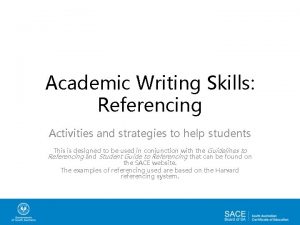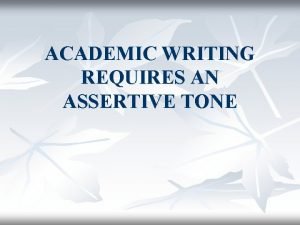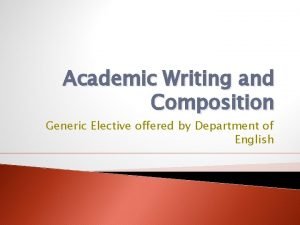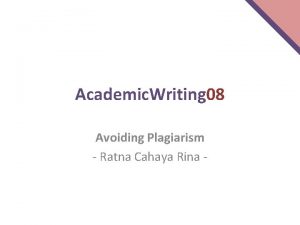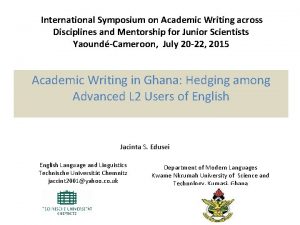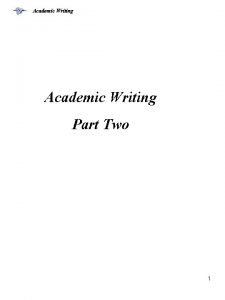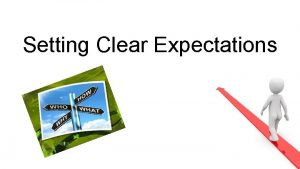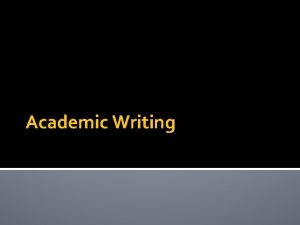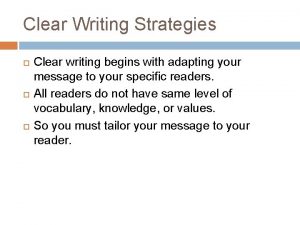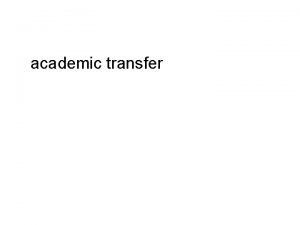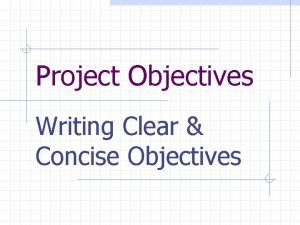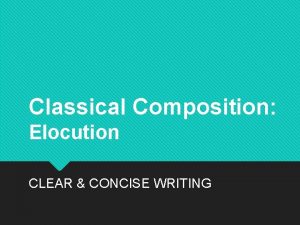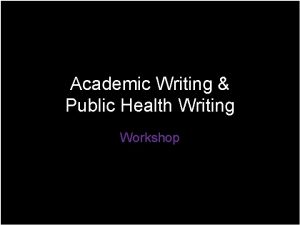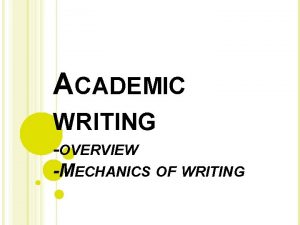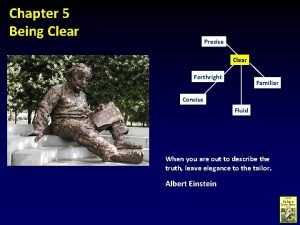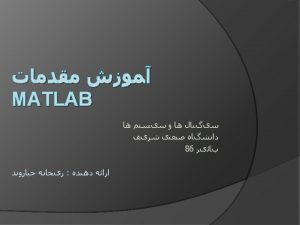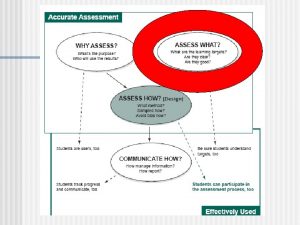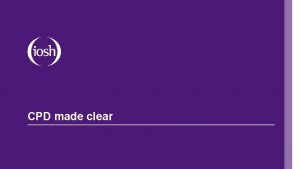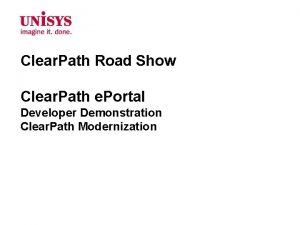Getting reacquainted with academic writing Clear writing Writing


















![Rewrite: Never hand in the first draft “Every [piece] is worked over several times. Rewrite: Never hand in the first draft “Every [piece] is worked over several times.](https://slidetodoc.com/presentation_image_h/2a96fe20e43fb7ddfd553256b1e353c7/image-19.jpg)


- Slides: 21

Getting reacquainted with academic writing….

Clear writing: Writing is about telling a story…. - Beginning, middle, end - Main idea - Tone

Clear, Academic Writing • Logical – Get the reader from A to B • Formulaic – The steps from A to B are the same

Making it Logical Basic approach to any paper u Look across your notes, research for patterns: u What is the punch line? What is the big take away you want the reader to get? u Start with the end: the punch line. Make it the opening. u Everything in the essay moves the reader to this punch line. u For a 3 -5 page paper, write the four bullet points that get you from the opening to your conclusion. u Back up each bullet point with the evidence that supports it. u Normally this would be research evidence; in general it would be examples, clarifications. u Cluster like ideas: discuss a topic only once. u Each subsequent section should take us a step closer to the punch line.

Clear writing tells the reader where you are going • Tell us where we are going (Three patterns emerged in their responses, relative to the literature – this, that, and this. Then develop each reason). – Note, we often write in 3 s • On longer papers, use headings to signal a change in topic • Use transition sentences to connect one paragraph to the next

Backbone of the Paper: the Paragraph • Must have a reason for being • Should have only one main idea • Two key components: topic sentence and evidence to back it up.

The “Bones” of a Paragraph: the Sentences “Vigorous writing is concise. A sentence should contain no unnecessary words, a paragraph no unnecessary sentences, for the same reason that a drawing should have no unnecessary lines and a machine no unnecessary parts. ” (Strunk & White, 1979, p. 23)

Construct Clear Sentences • Know the point you want to make • Say exactly what you mean – don’t be lazy • Use correct grammar – bad grammar to a reader is like a pothole to a driver; it interrupts the trip • Use shorter rather than longer sentences • Use the best noun, the best verb – No adverbs, no adjectives, no jargon – Write for your educated neighbor

Say precisely what you mean • Ambiguity = the reader has to guess your meaning – Guessing slows the reader down – Guessing = errors in understanding when the reader has to fill in the blank • Write positively – “not successful” becomes “unsuccessful” • Write actively – “a meeting was held” becomes “the board held a meeting” • If your sentence doesn’t clearly show who did what, you are probably writing in the “passive voice” – and making the reader guess • Put the subject at the start of the sentence – Not “It” or “There was” or “This” – these are weak nouns – If I read “This was important, ” because you haven’t said what “this” is, I have to guess

Saying what you mean • “Teachers are the main thing in schools. This is important because otherwise kids fail. ” (huh? ) – What about teachers? – What’s a main thing? – This WHAT? – Important HOW? – Other than what? (otherwise)

Let the evidence tell the story • Your credibility is built with evidence and tone • Tone: neutral – Word choice is one tool – Describe the behavior rather than judge it – Ex: He clearly and blatantly ignored the basic tenets of teaching. VS – He did not let children use the restroom for 3 hours; he called on boys but not girls; and he instructed one child to stand in the corner for 30 minutes as a punishment for talking back. These strategies have been criticized in the research literature (Author, Year). • Evidence: use the data, not emotion – Ex: The drop out rate is horrific. Vs. – In 2003, the overall four year high school completion rate in California was 67%; for whites, it was 77%; for Latino/as it was 56%; for African Americans it was 54%; and for Asians, 84% (http: //gayleturner. net/graduation_rates. html). • Every assertion needs evidence – either data or a source – You can use an interview as a source, but make it clear that the idea is the interviewee’s. – Present data – Provide citations for articles that make the case

Drop useless phrases • • “What I would like to signal here is that. . ” “My contention is that…” “What I want to make clear is that…” “The first is that…” Cut everything up through “that” and then start the sentence.

Edit Down • Replace long expressions with fewer words. • Omit adverbs (“quickly”) and adjectives (“pretty”) then see if the sentence retains its meaning. • Do not use “this” as a noun. This WHAT?

Shorter vs Longer: Edit down 1 Teacher preparation programs typically spend a great deal of time acquainting prospective student teachers with how to teach information. 2 Teacher preparation programs typically spend considerable time on teaching about pedagogy. 3 Most teacher preparation programs emphasize pedagogy.

Grammar Peeve #1: Tricky sentence structure: Use it correctly or don’t use it Opening with a prepositional phrase: Incorrect: “Dealing with drug side effects, aspirin helped her condition. ” Correct: “Dealing with drug side effects, Felicia found that aspirin helped her condition. ” The subject must come right after the comma.

Peeve #2 Opening with an adjective or adverb (remember, we don’t want these anyway) Incorrect: “Undamaged by centuries of sand, she climbed the intact steps. ” Correct: “Undamaged by centuries of sand, the steps looked intact. ” The subject of the phrase follows the comma.

Creating the first draft “Write freely and as rapidly as possible, and throw the whole thing down on paper. Never correct or rewrite until the whole thing is down. Rewriting in this process is usually found to be an excuse for not going on. ” - John Steinbeck

Good writing: no excuses • No one has time to write. Successful writers reassign time that used to go to other activities. • All good writers write, edit and rewrite each section several times. • Get a writing partner or two. Read each other’s drafts. Hold each other accountable. • We do not expect that the draft we read is your first or even second draft.
![Rewrite Never hand in the first draft Every piece is worked over several times Rewrite: Never hand in the first draft “Every [piece] is worked over several times.](https://slidetodoc.com/presentation_image_h/2a96fe20e43fb7ddfd553256b1e353c7/image-19.jpg)
Rewrite: Never hand in the first draft “Every [piece] is worked over several times. I like to compare my method with that of painters…proceeding, as it were, from layer to layer. The first draft is quite crude, far from being perfect, by no means finished…After that I rewrite as many times -applying as many ‘layers’ as I feel to be necessary. ” -Alberto Moravia

You aren’t done until you’ve edited and revised • Let a draft sit for 24 hours • Have someone else read it • Read it out loud to catch grammar and coherence problems

Final Thought… Writing is a tool – you want to tell a story but first you must: a) Know what the story is and b) Tell it in a way your audience will understand Use the conventions of writing (organization, grammar) to help you tell the story.
 Getting ahead
Getting ahead Technical academic writing
Technical academic writing Business writing vs academic writing
Business writing vs academic writing Robert gunning principles of clear writing with examples
Robert gunning principles of clear writing with examples Clear thinking and writing second edition answer key
Clear thinking and writing second edition answer key Clear thinking and writing john langan
Clear thinking and writing john langan How to write a introduction to an essay
How to write a introduction to an essay Uefap
Uefap Unity in academic writing
Unity in academic writing Quote about academic writing
Quote about academic writing Nominalisation in academic writing examples
Nominalisation in academic writing examples Fallacies in academic writing
Fallacies in academic writing Academic style
Academic style Myth or legend is academic writing
Myth or legend is academic writing Academic writing explicitness
Academic writing explicitness Harvard academic writing
Harvard academic writing How to list in academic writing
How to list in academic writing Assertive tone
Assertive tone Academic writing and composition
Academic writing and composition Contoh plagiarism
Contoh plagiarism Academic english reading and writing across the disciplines
Academic english reading and writing across the disciplines Formality in academic writing exercises
Formality in academic writing exercises


